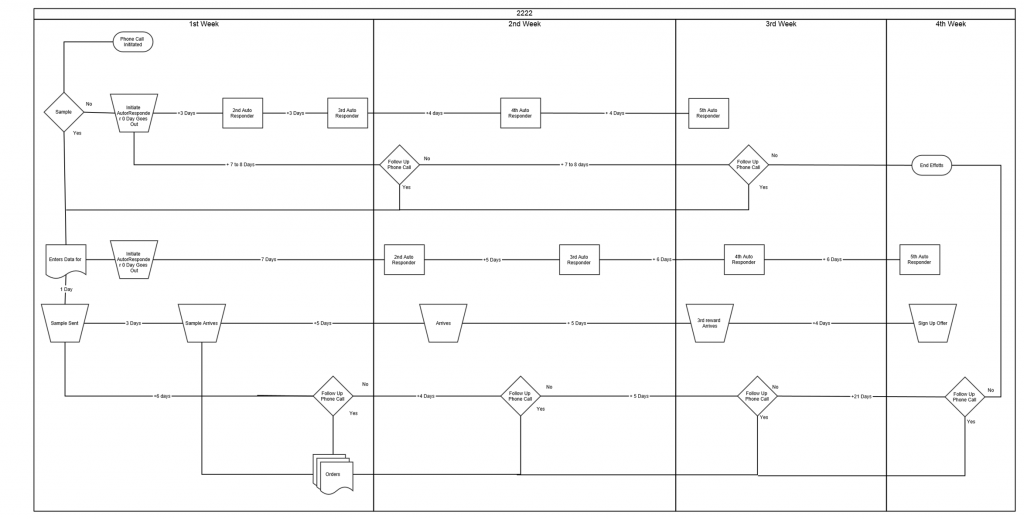Outside of blogging and podcasting, I do actually get a few real jobs that typically involve creating workflows to assist in managing and implement a change. This is done a variety of ways, and I take little credit for any success. I have followed John Kotter’s 8-Step Process for Change introduced in Leading Change as closely as anyone would let me. In a recent book, Designing for Behavior Change: Applying Psychology and Behavioral Economics, I discovered a different approach and to demonstrate I will use a workflow that combines an auto-responder, mail program and phone calls. We can extend the components to include events/tasks and/or lengthen time between the components. In this particular workflow, I assume a 21 to 28 day cycle.
Paraphrased from the book, Designing for Behavior Change: Applying Psychology and Behavioral Economics:,
The big picture would focus on the constructing the environment, preparing the user, structuring the action. The little picture will be the Cue, Reaction, Evaluation, Ability, Timing or the acronym CREATe (forget the last e). For the sake of brevity, I am not going to discuss the overall the environment, but it certainly should be part of the discussion. I would mention that it is important to frame the people we talk to for the callers and the different roles they may be calling into: the different type of positions, etc.
We begin by testing, creating different time frames for different segments as time goes on. We can also alter messages as segments are created. However, the key is getting our people to use the present system in its simplest form. Once everyone starts using the process, the real work begins. When we start complicating the order, the process; we take the decision making and the ability to ACT tougher involving more processes and people. The simplest basic offering allows people to act without delay.
If we consider the CREATe acronym for each week, we can attempt to enable one simple task by the customer during the week. To accomplish this the entire workflow needs to be tied together: mailing, the call and the Auto-Responder. All three of them should be related, setting-up the next segment while providing an easy way to act. The combination of them should form CREATe.
CREATe is described as:
Cue: Something to start the person/organization thinking about the action. Ideally it would not be what we do but could be a sales call or presentation.
Reaction: There is an immediate thought when the cue takes place that we must get past what is created by the intuitive mind. A sales call is often seen as a negative and reacted to accordingly. Records, Computer data entry bring up negative reactions for many.
Evaluation: The conscious mind evaluates the cost and benefits of the action, taking the above sales phone call. It is a relative action often weighed to the present moment. Is it worth taking the call over what I am doing?
Ability: The person has the ability to act on what we ask right NOW, as immediate as possible. If we ask for a reaction does that person have everything needed to complete the action. Do they have all the information at their fingertips when they are ready to do what we ask them, if they don’t why ask?
Timing: What is the reason for acting NOW? It needs to be a small step.
We consider the CREATe acronym for each week(could be any time frame). Again, what we are trying to do is enable a simple, actionable item by our prospect. We then look at each week or look at an individual workflow to see how it can be improved over time. Once a standard process is created, questions can be considered for improvement:
Keeping in mind the big 3:
Constructing the environment: Does the user have a clear motivation? Do we provide feedback?
Structuring the action: What is the course of action? Are we leveraging prior knowledge? Are we creating a minimum amount of work?
Preparing the user: Do we match the action with the user?
What about improving our CREATe?
Cue (Increase power of Cue): Tell the user the action; make it clear where to act? Simple message
Reaction (Increase interest and trust): Social proof? Strong authority on subject, Authenticity and Personal
Evaluation (Increase motivation, decrease cost of action (risk)): Peer Comparisons, Competition, Leverage loss aversion, Avoid choice overload, Avoid Direct Payments
Ability (increase feasibility, decrease constraints): Understand and Simplify implementation intentions, decrease burden of action, Peer comparisons
Timing (Increase urgency): Frame text for simplification, Remind of prior commitment, Make commitment to others, Make reward unique, and Focus on immediate rewards
What about that small e? CREAT enables the person/organization to eXECUTE the action
Primary source of material: Designing for Behavior Change: Applying Psychology and Behavioral Economics
Lean Sales and Marketing: Learn about using CAP-Do
Special Marketing with Lean Book and Program offers on Facebook

